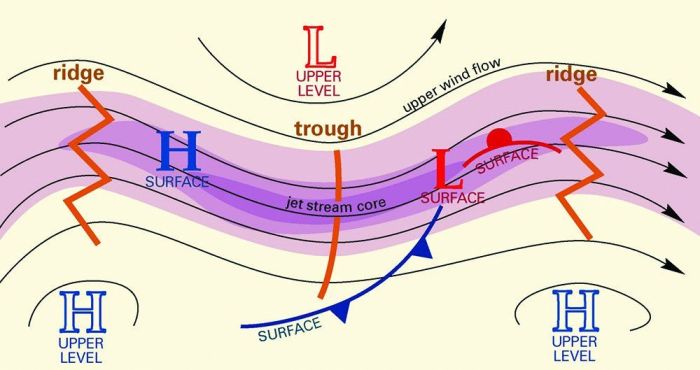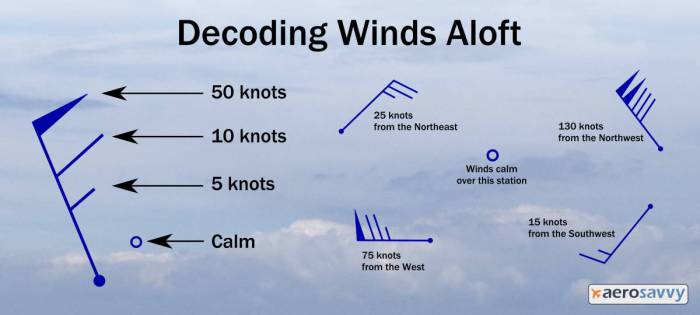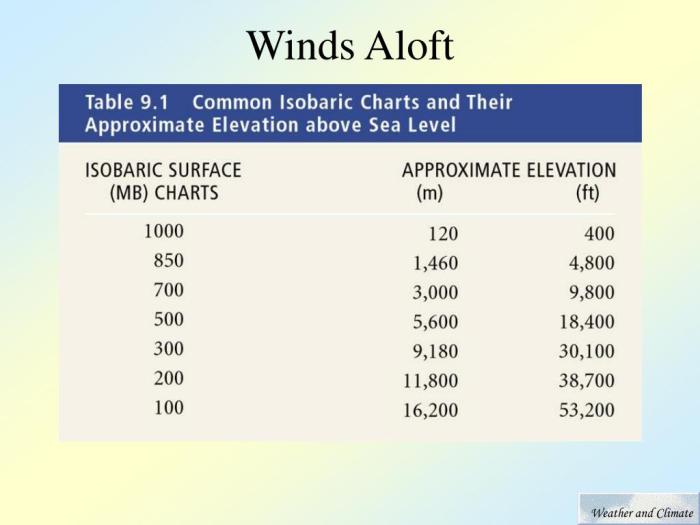Light and variable winds aloft, characterized by their unpredictable speed and direction, play a significant role in shaping weather patterns and influencing aviation. This article delves into the nature, effects, and forecasting of these elusive winds.
Light and variable winds aloft arise from atmospheric pressure gradients and wind shear, often occurring in transition zones between air masses or in areas of weak pressure gradients. They can influence cloud formation, precipitation, and the development of weather systems.
Definition and Characteristics of Light and Variable Winds Aloft

Light and variable winds aloft are characterized by their low speed and inconsistent direction. They typically occur at altitudes above the surface, where the influence of surface features and friction is reduced.
The speed of light and variable winds aloft is typically less than 10 knots (18.5 km/h), and their direction can vary significantly over short periods. These winds are often associated with weak pressure gradients and weak wind shear, which are the differences in wind speed and direction between different altitudes.
Causes of Light and Variable Winds Aloft
Light and variable winds aloft are primarily caused by a lack of strong atmospheric pressure gradients and wind shear. Pressure gradients are the differences in atmospheric pressure between two points, which drive the movement of air from high pressure to low pressure.
When pressure gradients are weak, the resulting winds are light and variable.
Wind shear is the difference in wind speed and direction between different altitudes. When wind shear is weak, the winds aloft are less likely to be deflected or disrupted, resulting in light and variable conditions.
Weather Conditions Associated with Light and Variable Winds Aloft
Light and variable winds aloft are often associated with clear or partly cloudy skies and calm surface winds. They are common during periods of high pressure or weak pressure gradients. These conditions can lead to stable atmospheric conditions, which are favorable for the formation of fog, smog, or haze.
Effects of Light and Variable Winds Aloft on Meteorology

Light and variable winds aloft can significantly influence meteorological phenomena. They play a crucial role in the formation, movement, and development of clouds, precipitation, and weather systems.
Influence on Cloud Formation and Precipitation
Light and variable winds aloft can affect the formation and movement of clouds by altering the vertical motion of air. When winds are weak and variable, there is less vertical mixing of air, leading to the formation of stable layers in the atmosphere.
These stable layers inhibit the upward movement of moist air, which can prevent cloud formation. Conversely, when winds aloft are stronger and more consistent, they can promote vertical mixing, creating conditions favorable for cloud development.
The movement of clouds is also influenced by winds aloft. Light and variable winds can cause clouds to drift slowly or even remain stationary, while stronger winds can transport clouds over long distances. This movement can affect the distribution of precipitation, as clouds carrying moisture can be transported to areas where they can release rain or snow.
Role in Weather System Development
Light and variable winds aloft can play a role in the development and movement of weather systems. For instance, in the formation of thunderstorms, strong updrafts are necessary to lift moist air to high altitudes where it can condense and form clouds.
Light and variable winds aloft can hinder the development of strong updrafts, making it less likely for thunderstorms to form.
Similarly, in the development of fronts, winds aloft can influence the movement and intensity of the front. When winds aloft are light and variable, fronts may move slowly and produce less precipitation. Conversely, stronger winds aloft can accelerate the movement of fronts, leading to more intense weather conditions.
Local Weather Patterns, Light and variable winds aloft
Light and variable winds aloft can also affect local weather patterns. For example, in coastal areas, light and variable winds aloft can lead to the formation of sea breezes during the day and land breezes at night. Sea breezes occur when the air over the ocean is cooler than the air over the land, causing a flow of cooler air from the ocean to the land.
Light and variable winds aloft often indicate fair weather conditions. As if through a pair of amber-tinted spectacles , the world seems brighter and more optimistic. These gentle breezes carry the promise of a calm and serene day, allowing us to bask in the warmth of the sun without worry.
Conversely, land breezes occur when the air over the land is cooler than the air over the ocean, causing a flow of cooler air from the land to the ocean.
In mountainous areas, light and variable winds aloft can influence the formation of mountain waves. When air flows over a mountain range, it can be forced to rise, leading to the formation of waves in the atmosphere. These waves can create areas of turbulence and can affect the weather conditions on the leeward side of the mountains.
Measurement and Forecasting of Light and Variable Winds Aloft

Accurate measurement and forecasting of light and variable winds aloft are crucial for aviation safety and weather prediction. Several methods are employed to gather data on these winds, including weather balloons and wind profilers.
Weather Balloons
Weather balloons are large, helium-filled balloons equipped with radiosondes that measure atmospheric conditions, including wind speed and direction. They are released into the atmosphere and ascend, transmitting data back to ground stations. Weather balloons provide vertical profiles of wind conditions, but their accuracy can be affected by factors such as balloon drift and instrument error.
Wind Profilers
Wind profilers are ground-based instruments that use radar or acoustic waves to measure wind speed and direction at different altitudes. They provide continuous data and can detect even light and variable winds. However, wind profilers have limited vertical range and can be affected by terrain and weather conditions.
Forecasting Challenges
Forecasting light and variable winds aloft poses significant challenges. These winds are often highly localized and can change rapidly, making it difficult to predict their behavior. Additionally, numerical weather prediction models may struggle to accurately represent these winds due to their small scale and variability.
Numerical Weather Prediction Models
Numerical weather prediction (NWP) models are computer simulations that use mathematical equations to forecast weather conditions. NWP models can provide guidance on light and variable winds aloft, but their accuracy is limited by the resolution of the model and the availability of high-quality input data.
Expert Answers
What causes light and variable winds aloft?
Light and variable winds aloft are primarily caused by weak pressure gradients and wind shear, often occurring in transition zones between air masses.
How do light and variable winds aloft affect aircraft performance?
Light and variable winds aloft can increase fuel consumption and flight duration, requiring pilots to adjust their flight plans accordingly.
How are light and variable winds aloft measured and forecasted?
Light and variable winds aloft are measured using weather balloons and wind profilers. Forecasting these winds can be challenging, but numerical weather prediction models are used to provide forecasts.


